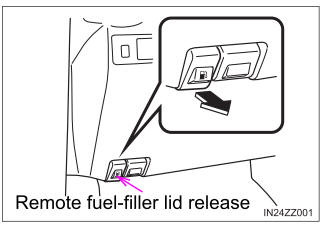Toyota Yaris: Tire Information (U.S.A.) / Tire Maintenance
Improper or inadequate vehicle maintenance can cause tires to wear abnormally. Here are some important maintenance points:
Tire Inflation Pressure
Inspect all tire pressure monthly (including the spare) when the tires are cold. Maintain recommended pressures for the best ride, top handling, and minimum tire wear. Use the pressures specified on the vehicle tire information placard or tire label for optimum service.
Tire Rotation
To equalize tire wear and extend tire life, Toyota recommends that tire rotation is carried out at the same interval as tire inspection.

Inspect the tires for uneven wear and damage. Abnormal wear is usually caused by one or a combination of the following:
- Incorrect tire pressure
- Improper wheel alignment
- Out-of-balance wheel
- Severe braking
After rotation, inflate all tire pressures to specification and inspect the lug nuts for tightness.
NOTICE
Rotate unidirectional tires and radial tires that have an asymmetrical tread pattern or studs only from front to rear, not from side to side. Tire performance will be weakened if rotated from side to side.
Replacing a Tire
If a tire wears evenly, a wear indicator will appear as a solid band across the tread. Replace the tire when this happens.
You should replace the tire before the band crosses the entire tread.

- New tread
- Worn tread
- Tread wear indicator
Tires degrade over time, even when they are not being used on the road. It is recommended that tires generally be replaced when they are 6 years or older. Heat caused by hot climates or frequent high loading conditions can accelerate the aging process. You should replace the spare tire when you replace the other road tires due to the aging of the spare tire. The period in which the tire was manufactured (both week and year) is indicated by a 4-digit number. Refer to Tire Labeling.
WARNING
Always use tires that are in good condition
Driving with worn tires is dangerous. Reduced braking, steering, and traction could result in an accident.
Safety Practices
The way you drive has a great deal to do with your tire mileage and safety. So cultivate good driving habits for your own benefit.
- Observe posted speed limits and drive at speeds that are safe for the existing weather conditions
- Avoid fast starts, stops and turns
- Avoid potholes and objects on the road
- Do not run over curbs or hit the tire against the curb when parking
NOTICE
If you feel a sudden vibration or ride disturbance while driving or you suspect your tire or vehicle has been damaged, immediately reduce your speed. Drive with caution until you can safely pull off the road. Stop and inspect the tire for damage. If the tire is under-inflated or damaged, deflate it, remove the tire and rim and replace it with your spare tire. If you cannot detect a cause, have the vehicle towed to the nearest vehicle or tire dealer to have the vehicle inspected.
 Location of the Tire Label (Placard)
Location of the Tire Label (Placard)
You will find the tire label containing tire inflation pressure by tire size
and other important information on the driver’s side B-pillar or on the
edge of the driver’s door frame...
 Vehicle Loading
Vehicle Loading
This section will guide you in the proper loading of your vehicle, to
keep your loaded vehicle weight within its design rating capability.
Properly loading your vehicle will provide maximum return of vehicle
design performance...
Other information:
Toyota Yaris XP210 (2020-2025) Reapir and Service Manual: Components
COMPONENTS ILLUSTRATION *1 FUEL INJECTOR ASSEMBLY *2 FUEL DELIVERY PIPE *3 FUEL INJECTOR SEAL *4 C-RING *5 NO. 3 FUEL INJECTOR BACK-UP RING *6 O-RING *7 NO. 1 FUEL INJECTOR BACK-UP RING *8 NOZZLE HOLDER CLAMP *9 INJECTOR VIBRATION INSULATOR *10 NO...
Toyota Yaris XP210 (2020-2025) Reapir and Service Manual: Inspection
INSPECTION PROCEDURE 1. INSPECT REAR DRIVE SHAFT ASSEMBLY (a) Check that there is no excessive play in the radial direction of the outboard joint. (b) Check that the inboard joint slides smoothly in the thrust direction. (c) Check that there is no excessive play in the radial direction of the inboard joint...
Categories
- Manuals Home
- Toyota Yaris Owners Manual
- Toyota Yaris Service Manual
- G16e-gts (engine Mechanical)
- Diagnostic Trouble Code Chart
- Starting the Engine
- New on site
- Most important about car
Refueling
Before refueling, close all the doors, windows, and the liftgate/trunk lid, and switch the ignition OFF.
To open the fuel-filler lid, pull the remote fuel-filler lid release.

